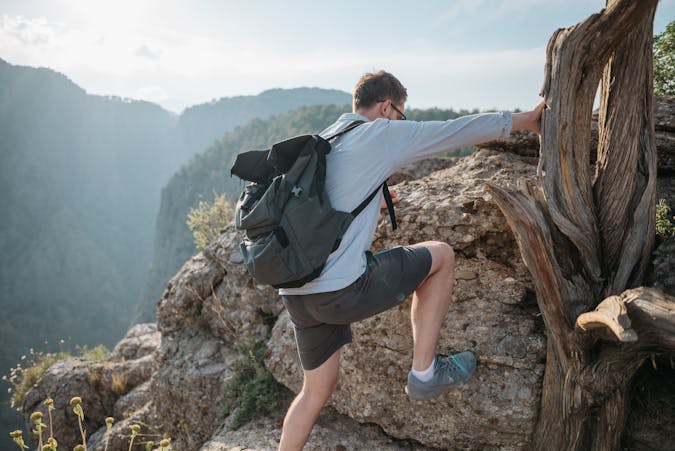
I’ve had my trusty backpack for years. It’s hiked the world with me, survived countless trails, and become more like an old friend than just a piece of gear. However, not too long ago, I grabbed my husband’s backpack for a day hike. Big mistake! It didn’t fit right and caused a lot of pain in my left hip. Never again will I underestimate the importance of a good fit.
When it comes to hiking backpacks, fit trumps all other features. It doesn’t matter how many cool gadgets or pockets a pack has if it doesn’t sit right on your body. An ill-fitting backpack can turn a pleasant hike into a painful ordeal, affecting your balance, posture, and overall comfort.
Knowing how to fit a hiking backpack is a must.
A well-fitted backpack distributes the weight properly, 80% on your hips and 20% on your shoulders, reducing strain on your back and shoulders. This means you can hike longer and more comfortably without constantly adjusting your pack or dealing with painful hotspots. Think of it like a good pair of hiking boots; comfort is key.
So, before you get swayed by flashy designs or extra features, remember that a well-fitted backpack is your best companion on the trail. It enhances your hiking experience and keeps you focused on the beauty around you, not the pain caused by a poor fit.
Choosing the Right Fit: Prioritize Fit Over Features
When picking out a hiking backpack, it’s easy to get drawn in by a sleek design or a cool color. But trust me, comfort is where it’s at. A fancy-looking pack won’t do much good if it feels like carrying a bag of rocks on your shoulders.
Many hikers make the mistake of choosing a pack based on its storage capacity or fancy features like hydration systems and extra pockets. While those can be handy, they don’t mean much if the base fit is off. Get the fit right first, then worry about the extras.
Prioritizing a good fit over extra features is the way to go. Start with the basics: make sure the backpack sits comfortably on your hips and shoulders. This is the foundation of a good fit. The right pack should almost feel like an extension of your body, not like it’s fighting against you with every step.
Comfort comes first. A well-fitted pack can make a six-hour hike feel like a breeze, while an ill-fitted one will have you counting down the minutes till you can take it off. Spend the time to get it right and your back, shoulders, and hips will thank you.

Gender-Specific Packs and Back Length Considerations
Male v Female Packs
If you ever wondered if a backpack could really be one-size-fits-all, here’s the scoop: it can’t. Gender-specific packs play a key role in making your hike comfy and enjoyable. Women’s packs are designed for shorter torsos and wider hips, while men’s packs cater to broader shoulders and longer torsos. This isn’t about marketing gimmicks; it’s about ergonomics and comfort. This was my mistake, using a male backpack that was too long for my torso. Never again.
The Importance of Back Length
Now, let’s talk about back length. A pack’s size isn’t determined by your height; it’s all about the length of your back. Measure from the base of your neck (the C7 vertebra) down to the top of your hip bones (the iliac crest). This measurement is crucial for distributing the pack’s weight correctly and preventing strain on your spine.
Choosing a pack with an adjustable back panel is also a good move. This feature allows you to modify the fit as you go, ensuring you can tweak it for the best possible comfort as your body settles into the hike. Some packs even come with removable back panels to adapt to different torso lengths.
The right fit goes beyond just strapping a backpack on and heading out the door. Gender-specific packs, customizable features, and the right back length are all integral steps to make sure you’re prepared for a comfortable, enjoyable ans safe hike. A backpack that sits too high and above your head can impact your balance.
Step-by-Step Guide to Fitting Your Backpack
Okay, you’ve got the perfect pack. Now, let’s make sure it fits just right. A well-fitted backpack should feel like a natural extension of your body. Here’s a step-by-step guide to get you dialed in.
- Hips First: Start with the hip belt. This is where most of the weight should rest, so it’s key to get it right. Position the hip belt on your hips, not your waist, aligning it with your iliac crest. Tighten it snugly but not too tight—you don’t want to feel like you’re in a vice grip.
- Shoulder Straps: Next, adjust those shoulder straps. Pull the straps down and back, ensuring the pack doesn’t lift off your hips. The shoulder straps should wrap comfortably around your shoulders, without any gaps.
- Yoke Position: Now, focus on the yoke position. The yoke should sit about 5 cm below that C7 vertebra we talked about earlier. This will help balance the pack and reduce strain on your shoulders and neck.
- Load Lifters: Don’t forget the load lifters. These little guys should be at a 40-50° angle. Adjust them to keep the weight close to your body and maintain balance, making it easier to carry heavy loads.
- Sternum Strap: Lastly, check the sternum strap. Position this strap just below your armpits and tighten it lightly. This helps keep the shoulder straps in place and stops them from slipping off.
Before hitting the trail, do a final fit check. Make sure everything feels snug but comfortable. The majority of the weight should be on your hips, not your shoulders. Walk around a bit, make adjustments as needed, and get a feel for the pack.
Testing and Continual Adjustment: Ensuring Comfort on the Trail
Got your backpack all fitted? Now it’s time to put it to the test. For your first outing, choose a short trail. This gives you a chance to make minor adjustments without being far from home. You want the hip belt to conform to your body shape and discover any pressure points early on.
Once you’re on the trail, don’t hesitate to tweak as you go. The perfect fit often needs real-world adjustments. Loosen the shoulder straps for a few minutes to give your shoulders a break, then tighten them back up. If the hip belt starts to feel loose, readjust it to maintain support.
Pay attention to how the pack feels over the course of your hike. Little tweaks can make a huge difference in comfort. If you’re starting to feel pinching or soreness, stop and adjust. Being proactive keeps minor discomforts from turning into major issues.
Remember, a well-fitted pack can still need adjusting as your body shifts and adjusts to the load. Continuous small tweaks can help maintain comfort throughout your hike. It’s like fine-tuning a musical instrument; sometimes, a small turn of the peg can make all the difference.
In the long run, taking the time to adjust your backpack properly and make continuous tweaks during your hikes will lead to a more enjoyable and pain-free experience. Happy hiking!
Have you had any pack experiences you would like to share or any questions, please ask away.

There is nothing worse than carrying an uncomfortable hiking backpack, especially if you have long distances to cover. Many people do make the mistake of going for the looks rather than how practical the backpack is when purchasing it. However, it is important to try it on in the shop and even put some weight in it to see how it feels and whether it suits your posture.
You have also provided great tips here on measuring your back length, as I am sure getting the right length also makes a huge difference.
Well, well, well… looks like I’ve got a lot to learn about backpacks! Your post really opened my eyes. Who knew there was so much to fitting these things?
That bit about using your husband’s pack made me chuckle. Reminds me of the time I borrowed my sister’s tiny daypack for a camping trip. Let’s just say it wasn’t pretty!
I’m heading to REI this weekend to try on some packs. Any sneaky tips for getting the best fit? Should I bring my own weights or something?
Those load lifters sound interesting. My lower back always kills me after carrying heavy stuff especially noticed that when I buy groceries and put them in my backpack. Think focusing on the hip belt might help?
Oh, and the gender-specific pack thing threw me for a loop. I’m a guy, but I’ve got narrow shoulders. Reckon I should check out women’s packs too?
Your posts are seriously upping my hiking game. First gear, then stretching, now this. I’m feeling pretty good about tackling that local trail I’ve been eyeing. Here’s hoping I don’t look like a total greenhorn out there!
Hi there, Your pack should be fitted according to your back measurement. Having your pack sitting on your hips will help with the back pain. I’m glad your enjoying my articles and I hope they inspire you.
The wrong backpack can turn an adventurous journey into a painful slog. Choosing the right backpack goes beyond mere aesthetics; it demands thoughtful consideration of your unique physicality and travel needs. Proper fit is crucial—not only should it sit comfortably on your back, but it should also distribute weight evenly to minimize strain during long treks.
Great article and something people should think about before purchasing a pack on looks or a special feature.
Lyn, I’m seriously going to start calling you the mighty Babe Ruth—you just keep hitting them out of the park! Another home run article! Honestly, I’ve always picked backpacks based on size and looks. Sure, I’d try them on, but I never really thought much about how the fit or features, like the length of my back or my wife’s, could make such a difference. Wow! What an eye-opener. This guide is fantastic, and I’m definitely going to rethink my next backpack purchase. I can’t wait to read more from you! Keep these gems coming.
Thanks again!
Opa